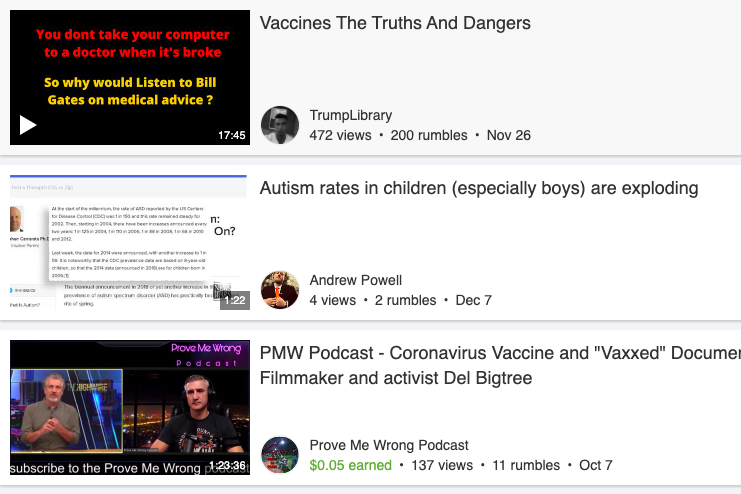

Tasos Katopodis/Getty Images
On Monday, a user on the streaming site Rumble posted a video titled “TRUMP GOT 316 ELECTORAL VOTES TODAY! STILL LEADS CHINA JOE! BILL BARR RESIGNS 2020 ELECTION.” In it, an unseen narrator attempts to explain that Georgia, Pennsylvania, Wisconsin, Michigan, Arizona, Nevada, and New Mexico are still “up for grabs” at this late date. (They aren’t.) The user also claims that proof of systemic election fraud would invalidate enough votes to hand President Donald Trump a victory, a false narrative that his supporters have been clinging to since November. This video wouldn’t be allowed on YouTube under the site’s policies around election misinformation. Luckily for conspiracy-minded content creators, Rumble doesn’t have misinformation policies.
Advertisement
Rumble is one of several upstart social media platforms that pro-Trump users are flocking to, in part because they offer a more hospitable alternative reality. For years now, some conservative pundits have called on their supporters to decamp from mainstream social networks to newer websites with looser moderation standards. None of the options has taken off—except, sometimes, with far-right trolls and neo-Nazis. But after platforms like Facebook, Twitter, and YouTube put their feet down, to various extents, over misinformation surrounding voter fraud during the 2020 election, some right-leaning users began responding to this call en masse. Parler, an alternative to Twitter, shot up to the top spot in the Apple App Store’s download charts on Nov. 8, the day after mainstream news outlets called the presidential race for Biden. Rumble, an alternative to YouTube, has been seeing similar gains from the election. Rumble is certainly a small fish compared with the Google-owned video platform and its 2 billion users. But Fortune reports that the site currently has 80 million users, up from 40 million in August. Perhaps more revealingly, streaming on Rumble as measured by bandwidth use has increased 26-fold in that timespan.
Advertisement
Advertisement
Advertisement
Why are Trump dead-enders and other right-wing users fleeing YouTube? During the election, the platform stepped up its misinformation enforcement, though not nearly as much as Facebook and Twitter. YouTube even came under fire from misinformation researchers and journalists for allowing videos from frequently bogus sources like One America News Network to stay up and disseminate falsehoods about voter fraud, but it did end up putting labels on election videos notifying users that the Associated Press had called the race for Biden. By the end of November, though, YouTube had temporarily suspended and demonetized OANN after it promoted phony COVID-19 cures. This was a bridge too far for OANN, which ultimately migrated to Rumble. (YouTube also announced this past Wednesday, a day after the safe-harbor deadline for Congress to officially recognize votes from states’ chosen electors, that it would start removing any content that “misleads people by alleging that widespread fraud or errors changed the outcome of the 2020 U.S. Presidential election.”)
Advertisement
Advertisement
Rumble was founded in 2013 by Chris Pavlovski, a tech entrepreneur from North Macedonia. The company is headquartered in Toronto and relies on a small staff of around a dozen people, though it also contracts workers from Cosmic Development, another venture founded by Pavlovski. The Rumble.com domain had been a present from a friend for Pavlovski’s 30th birthday. Unlike Parler, which was co-founded by a member of the billionaire pro-Trump Mercer family, Rumble wasn’t intended to be a platform specifically for conservatives. The site ended up attracting right-leaning celebrities and conspiracy theories this year, though, partly thanks to its lax moderation policies. According to BuzzFeed, Pavlovski originally saw the site as a way to help small-time creators who weren’t influencers or big brands to still make money with a compensation model that paid them through licensing content and ad revenue. (Rumble’s partners like MSN, Yahoo, and MTV can pay creators to license videos. Creators can also earn $100 if a video makes it to Rumble’s front page. YouTube users typically earn revenue from ads.) Up until the last three months or so, Rumble subsisted on cute animal and baby videos, along with news from mainstream sites like Reuters. After California Rep. Devin Nunes started posting his podcast there over the summer, however, it became a stomping ground for right-wingers like Dinesh D’Souza, Sean Hannity, and Ohio Rep. Jim Jordan. Pavlovski is now trying to recruit more big-name political figures, and is now presenting Rumble as a site that won’t ever fact-check or “censor political discussion, opinion or act like the arbiters of truth,” as he told the Washington Examiner. He also promised that Rumble has “no desire to change our policies every month due to external pressure.”
Advertisement
Advertisement
Advertisement
At the center of Rumble’s growth is Dan Bongino, an author and one of Fox News’ die-hard pro-Trump contributors, who partly made the switch to Rumble because YouTube had been demonetizing his videos. Bongino purchased stakes in both Parler and Rumble several months before the election and has been urging his fans to join the two sites. A quick survey comparing Bongino’s YouTube videos and his Rumble videos, however, suggests that there isn’t a whole lot of difference between what he posts on the two platforms. However, he has a few thousand more subscribers on Rumble, and many of his videos there attract more viewers than they do on YouTube. The same is true for D’Souza and the Federalist.
Advertisement
In terms of the user experience, Rumble is basically the same as YouTube and other major video-sharing platforms. In terms of moderation, though, Rumble is certainly more permissive with fallacious videos. Simply searching “vaccine” or “vaccine autism” surfaces numerous examples of videos pushing anti-vaccine misinformation about the new coronavirus vaccines. Searching “stop the steal,” a popular slogan among Trump’s supporters who advance the false theory that voter fraud affected the outcome of the election, also turns up numerous videos with spurious claims of manipulated voting machines and “deep state” interference. Content promoting QAnon, the conspiracy theory that pedophiles control the Democratic Party and other major institutions, also seems to do well on Rumble; YouTube cracked down on QAnon in October. Rumble’s terms of use say that the platform forbids pornography, harassment, and illegal content like bomb-making instructions. That leaves plenty of room for conspiracy theories.
Advertisement


Rumble
It’s an open question whether Rumble can sustain its growth after Trump is no longer president and the supposedly fraudulent election is further in the rearview mirror. For the moment, though, the site is continuing to do quite well: On Friday, the company claimed in a tweet that its uploads had been growing by another 20 percent each day.
from WordPress https://ift.tt/3gP2nTe
via IFTTT


0 Comments